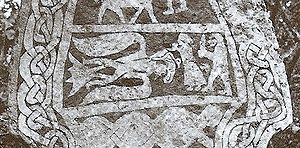
Mead of poetry
Encyclopedia

Norse mythology
Norse mythology, a subset of Germanic mythology, is the overall term for the myths, legends and beliefs about supernatural beings of Norse pagans. It flourished prior to the Christianization of Scandinavia, during the Early Middle Ages, and passed into Nordic folklore, with some aspects surviving...
, the Poetic Mead or Mead of Poetry (Old Norse skáldskapar mjaðar), also known as Mead of Suttungr (Suttungmjaðar), is a mythical beverage that whoever "drinks becomes a skald
Skald
The skald was a member of a group of poets, whose courtly poetry is associated with the courts of Scandinavian and Icelandic leaders during the Viking Age, who composed and performed renditions of aspects of what we now characterise as Old Norse poetry .The most prevalent metre of skaldic poetry is...
or scholar" to recite any information and solve any question. This myth was reported by Snorri Sturluson
Snorri Sturluson
Snorri Sturluson was an Icelandic historian, poet, and politician. He was twice elected lawspeaker at the Icelandic parliament, the Althing...
(Skáldskaparmál
Skáldskaparmál
The second part of Snorri Sturluson's Prose Edda the Skáldskaparmál or "language of poetry" is effectively a dialogue between the Norse god of the sea, Ægir and Bragi, the god of poetry, in which both Norse mythology and discourse on the nature of poetry are intertwined...
5) (1). The drink is a vivid metaphor for poetic inspiration, often associated with Odin
Odin
Odin is a major god in Norse mythology and the ruler of Asgard. Homologous with the Anglo-Saxon "Wōden" and the Old High German "Wotan", the name is descended from Proto-Germanic "*Wodanaz" or "*Wōđanaz"....
the god of 'possession' via berserker
Berserker
Berserkers were Norse warriors who are reported in the Old Norse literature to have fought in a nearly uncontrollable, trance-like fury, a characteristic which later gave rise to the English word berserk. Berserkers are attested in numerous Old Norse sources...
rage or poetic inspiration.
Creation of the mead of poetry and murder of Kvasir
After the Æsir-Vanir War, the gods sealed the truce they had just concluded by spitting in a vatVat
Vat or VAT may refer to:* A type of container such as a barrel, storage tank, or tub, often constructed of welded sheet stainless steel, and used for holding, storing, and processing liquids such as milk, wine, and beer...
. To keep a symbol of this truce, they created from their spittle a man named Kvasir
Kvasir
In Norse mythology, Kvasir was a being born of the saliva of the Æsir and the Vanir, two groups of gods. Extremely wise, Kvasir traveled far and wide, teaching and spreading knowledge. This continued until the dwarfs Fjalar and Galar killed Kvasir and drained him of his blood...
. He was so wise that there were no questions he could not answer. He travelled around the world to give knowledge to mankind. One day, he visited the dwarves Fjalar and Galar
Fjalar and Galar
In Norse mythology, Fjalar and his brother Galar, were dwarves who killed Kvasir and turned his blood into the mead of poetry, which inspired poets. They appear in Skáldskaparmál.- Myth :...
. They killed him and poured his blood into two vats and a pot called Boðn, Són and Óðrerir
Óðrerir
In Norse mythology, Óðrerir, Óðrørir or Óðrœrir refers either to one of the vessels that contain the mead of poetry or to the mead itself.-Poetic Edda:...
. They mixed his blood with honey, thus creating a mead
Mead
Mead , also called honey wine, is an alcoholic beverage that is produced by fermenting a solution of honey and water. It may also be produced by fermenting a solution of water and honey with grain mash, which is strained immediately after fermentation...
which made anybody who drank it a "poet or scholar" ("skáld eða frœðamaðr"). The dwarves explained to the gods that Kvasir had suffocated in intelligence.
From the dwarves to Suttungr

When Gilling's son, Suttungr, learned what had happened, he went to the dwarves' and led them to a reef which was covered with water at high tide. The dwarves implored him and offered him the mead in compensation for his father's death. Suttungr agreed. When he came back home, he stored the mead in a place called Hnitbjörg where his daughter, Gunnlöd
Gunnlod
In Norse mythology, Gunnlöð is a giantess. Her name could be written as Gunnlod.- Mythology :She is daughter of the giant Suttungr, who was set guard by her father in the cavern where he housed the mead of poetry. Her grandfather was Giling...
, was in charge of guarding it.
Theft by Odin

Then he spent the night at Baugi
Baugi
- Myth :Baugi is a son of Gilling and his wife, who were killed by two dwarves, Fjalar and Galar. His brother is Suttungr, and his niece is Gunnlöð. Suttungr had hidden the mead of poetry after obtaining it from Fjalar and Galar....
's place. Baugi was Suttung's brother. He complained that business did not go well since his slaves had killed each other and he could not get anybody to stand in for them. Odin, who said his name was Bölverk, proposed to do their work in exchange for a draught of Suttung's mead. Baugi agreed, saying that he would try to persuade his brother. During summer, Bölverk did the work as agreed and, in winter, asked Baugi for his owing. They both went to Suttung's, who refused to give a single drop of the beverage.

Rati (Norse mythology)
In Norse mythology, Rati is the name of a drill or auger that was used by Odin during his quest to obtain the mead of poetry from the giant Suttung with the help of Suttung's brother Baugi. According to the Skáldskaparmál section of the Prose Edda, Odin instructed Baugi to bore a hole with the...
and asked him to dig into Hnitbjörg mountain. After Baugi tried to deceive him, a hole was actually dug and Bölverk slipped into it, having taken the form of a snake. Baugi tried in vain to hit him with the drill.
He arrived by Gunnlöd, with whom he spent three nights. Thus he could have three draughts of mead. But each emptied a container. He then transformed into an eagle and flew away. When Suttung discovered the theft, he took the shape of an eagle and pursued Odin. When the Æsir saw him, they displaced containers in which he spat his loot out. But Suttung was so close to him that he let some drop backwards. Anybody could drink this part, which is known as the "rhymester's share" ("skáldfífla hlutr"). But the mead of poetry was given by Odin to the gods and to the men gifted in poetry.
Source
- Snorri SturlusonSnorri SturlusonSnorri Sturluson was an Icelandic historian, poet, and politician. He was twice elected lawspeaker at the Icelandic parliament, the Althing...
, EddaProse EddaThe Prose Edda, also known as the Younger Edda, Snorri's Edda or simply Edda, is an Icelandic collection of four sections interspersed with excerpts from earlier skaldic and Eddic poetry containing tales from Nordic mythology...
, translated and edited by Anthony Faulkes, London: Everyman, 1995, ISBN 0-460-87616-3.

